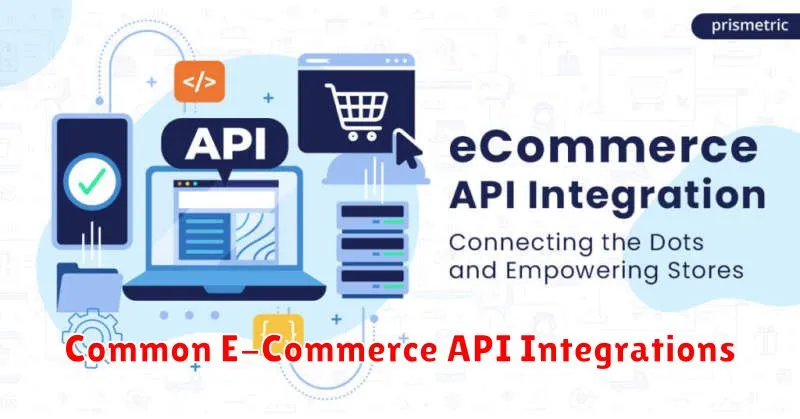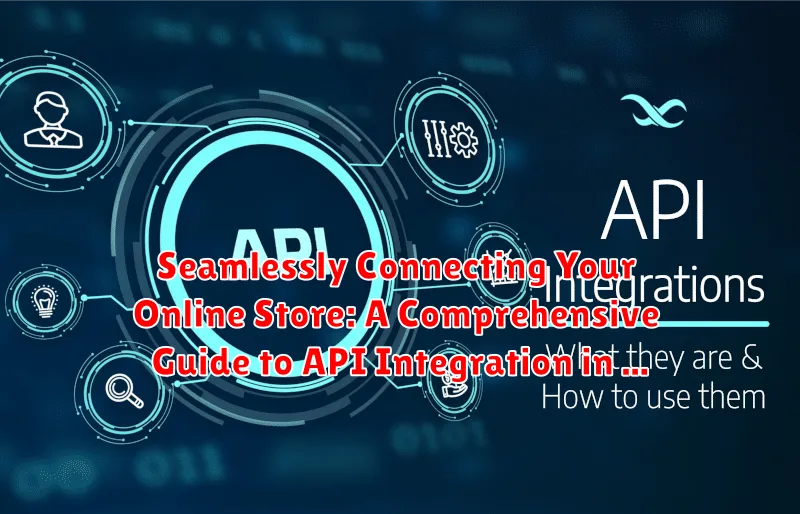In today’s interconnected digital landscape, API integration is no longer a luxury but a necessity for e-commerce businesses striving for growth and efficiency. This comprehensive guide explores the crucial role of API integration in seamlessly connecting your online store to various vital services, unlocking unprecedented levels of automation, data exchange, and streamlined operations. From managing inventory and processing payments to enhancing customer experience and expanding marketing reach, understanding and implementing effective API integrations can significantly impact your e-commerce success. This guide will delve into the benefits, challenges, and best practices for integrating APIs into your e-commerce platform, empowering you to make informed decisions and optimize your online business.
Whether you are a seasoned e-commerce entrepreneur or just starting your online journey, this guide will provide valuable insights into the world of API integration. We will cover various types of APIs relevant to e-commerce, including payment gateways, shipping providers, marketing automation tools, and customer relationship management (CRM) systems. Learn how API integration can revolutionize your e-commerce operations, allowing you to scale your business, personalize customer interactions, and gain a competitive edge in the ever-evolving online marketplace. By leveraging the power of API integration, you can create a truly connected and efficient e-commerce ecosystem that drives growth and maximizes profitability.
What is an API and Why Is It Important for E-Commerce?
An API, or Application Programming Interface, is a set of rules and specifications that software programs can follow to communicate with each other. Think of it as a messenger that allows different systems to exchange information and functionality seamlessly.
In the context of e-commerce, APIs are crucial for connecting your online store to various other platforms and services. They enable your website to interact with payment gateways, shipping providers, inventory management systems, marketing automation tools, and much more.
Without APIs, these integrations would require complex, custom-built solutions. APIs provide a standardized way for different software components to work together, streamlining processes and expanding the capabilities of your e-commerce platform. This allows for real-time data exchange, automation of tasks, and a more efficient and connected online business.
Different Types of APIs Used in E-Commerce
Several types of APIs play crucial roles in e-commerce, each serving specific functions. Understanding these distinctions is key to selecting the right APIs for your business needs.
REST APIs (Representational State Transfer) are the most common type in web services, including e-commerce. They rely on standard HTTP methods (GET, POST, PUT, DELETE) to interact with resources, offering a flexible and scalable solution for data exchange.
SOAP APIs (Simple Object Access Protocol) are more structured than REST APIs, using XML for data exchange and offering enhanced security features. They are often used for complex integrations requiring high reliability, though they can be less flexible.
GraphQL APIs allow clients to request specific data, reducing over-fetching and improving efficiency. This is particularly useful for mobile commerce, where bandwidth efficiency is important.
Webhooks provide real-time updates by pushing data to your application whenever an event occurs, unlike traditional APIs where you need to poll for changes. This is valuable for order updates, inventory changes, and other time-sensitive data.
Benefits of API Integration for Your Online Business
API integration offers numerous advantages for e-commerce businesses, streamlining operations and enhancing customer experiences. Improved efficiency is a key benefit, automating tasks like inventory updates and order processing. This automation frees up valuable time and resources, allowing your team to focus on strategic initiatives.
Enhanced customer experience is another significant advantage. APIs enable personalized shopping experiences by integrating with CRM and marketing automation platforms. Real-time data synchronization ensures accurate product information, pricing, and availability across all channels, reducing customer frustration.
Scalability and flexibility are also crucial benefits. APIs allow your business to easily adapt to changing market demands by integrating with new technologies and services. This adaptability ensures your e-commerce platform can handle growth and evolving customer expectations.
Data-driven insights are readily available through API integration. By connecting with analytics platforms, you gain valuable data on customer behavior, sales trends, and marketing campaign effectiveness. These insights empower informed decision-making and optimized business strategies.
Choosing the Right APIs for Your E-Commerce Platform
Selecting the appropriate APIs is crucial for maximizing the benefits of integration. Several key factors should guide your decision-making process. Begin by thoroughly assessing your business needs. Identify specific areas where API integration can address pain points or enhance functionality. Consider aspects like inventory management, shipping logistics, customer relationship management (CRM), and marketing automation.
Next, evaluate the compatibility of the API with your existing e-commerce platform. Ensure seamless integration and data flow between systems to avoid conflicts or disruptions. Scalability is another important consideration. Choose APIs that can accommodate your business growth and handle increasing data volumes and transaction loads.
Security should be a top priority. Verify that the API provider adheres to robust security protocols and data encryption standards to protect sensitive customer information. Finally, consider the cost and support offered by the API provider. Assess pricing models, documentation, and the availability of technical support to ensure a smooth integration and ongoing maintenance.
Common E-Commerce API Integrations

Several key API integrations are frequently used in e-commerce to enhance functionality and streamline operations. Understanding these common integrations can help businesses make informed decisions about which APIs best suit their needs.
Payment Gateway APIs
These APIs enable secure online transactions by connecting your store to payment processors. Stripe, PayPal, and Square are popular examples, facilitating credit card, debit card, and other digital payment methods.
Shipping APIs
Integrating with shipping carriers like UPS, FedEx, and USPS provides real-time shipping rates, tracking information, and automated label generation. This streamlines fulfillment and improves the customer experience.
CRM APIs
Connecting to Customer Relationship Management (CRM) platforms like Salesforce and HubSpot helps manage customer data, personalize marketing efforts, and improve customer service by centralizing valuable information.
Marketing Automation APIs
Integrating with platforms like Mailchimp and Klaviyo enables automated email campaigns, targeted advertising, and personalized product recommendations, leading to increased engagement and sales.
Best Practices for Secure and Efficient API Integration
Implementing APIs effectively requires careful planning and adherence to best practices. Security is paramount. Always use HTTPS for encrypted communication and implement robust authentication mechanisms like OAuth 2.0. Thorough input validation is crucial to prevent vulnerabilities like SQL injection and cross-site scripting attacks. Never trust external data without proper sanitization.
Rate limiting prevents overload and ensures fair usage. Implement clear and consistent error handling to gracefully manage issues and provide informative feedback. API documentation is essential for developers and facilitates smooth integration. Use a standard format like OpenAPI/Swagger to clearly define endpoints, request parameters, and responses.
For efficient integrations, employ techniques like caching to reduce redundant requests and improve performance. Consider using a dedicated API gateway to manage and optimize API traffic. Finally, thorough testing, including unit and integration tests, is vital to ensure reliability and identify potential issues early on.
Troubleshooting Common API Integration Issues
Integrating APIs can be complex, and issues may arise. This section covers common problems and solutions.
Authentication and Authorization Errors
Authentication failures often stem from incorrect API keys or secrets. Double-check your credentials and ensure they’re properly passed in the request headers. Authorization issues indicate insufficient permissions. Review the API documentation to confirm the required access levels and adjust accordingly.
Data Mapping and Format Errors
Discrepancies between your system’s data structure and the API’s expected format lead to data mapping errors. Carefully review the API documentation for expected data types and formats. Implement robust data validation and transformation logic to ensure compatibility.
Rate Limiting and Performance Issues
Exceeding API rate limits can cause requests to be throttled or rejected. Implement strategies to handle rate limits, such as request queuing and retry mechanisms. Performance bottlenecks can be diagnosed using profiling tools. Optimize your code and consider caching frequently accessed data.
Error Handling and Logging
Implement comprehensive error handling to gracefully manage API failures. Log errors with sufficient detail to aid in debugging. Use the API’s error responses to identify the root cause of the issue.
Future Trends in E-Commerce API Integration

The future of e-commerce API integration is marked by several key trends focused on enhancing interoperability, scalability, and personalization.
AI-powered integrations are becoming increasingly prevalent. These integrations leverage machine learning to automate tasks, personalize product recommendations, and optimize pricing strategies. This leads to more efficient operations and improved customer experiences.
Headless commerce is another growing trend. Decoupling the front-end and back-end of e-commerce platforms allows for greater flexibility and customization. This empowers businesses to create unique and engaging shopping experiences across various touchpoints.
The rise of serverless architecture simplifies API integration by abstracting away server management. This reduces operational overhead and allows developers to focus on building and deploying integrations more quickly.
Finally, the increasing emphasis on real-time data synchronization is crucial. APIs are evolving to provide instantaneous updates on inventory, orders, and customer information, leading to improved accuracy and responsiveness across all platforms.

